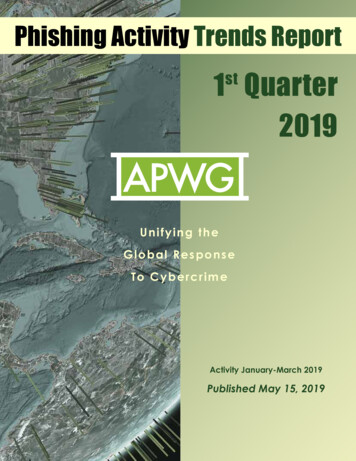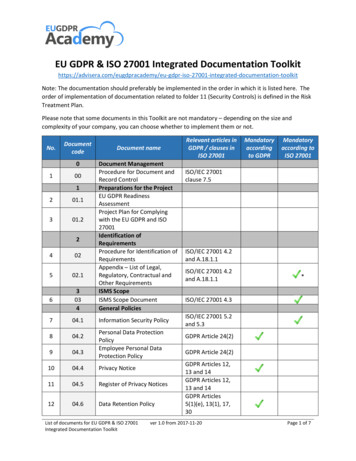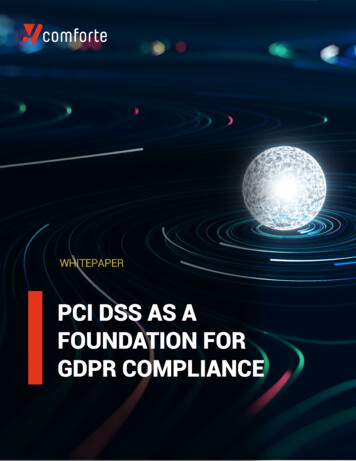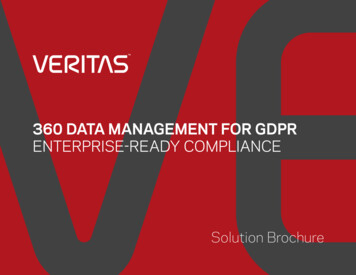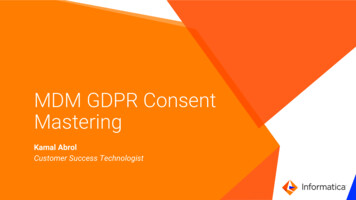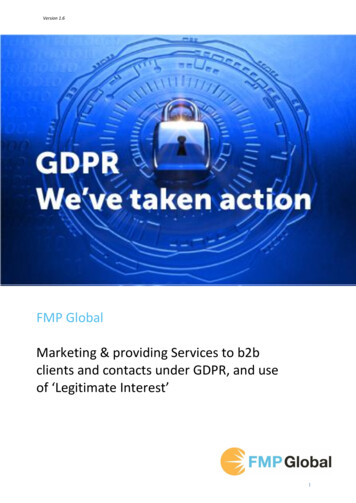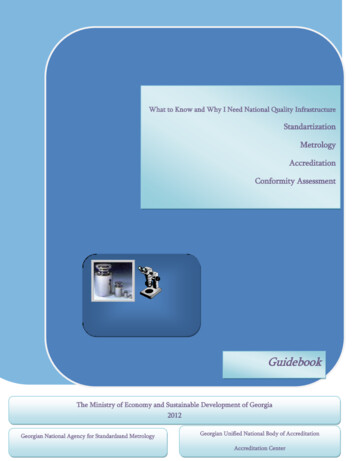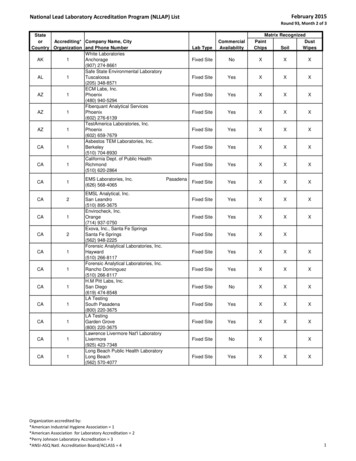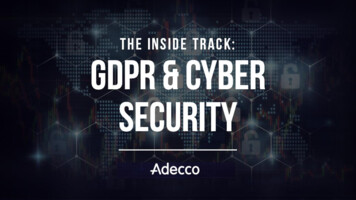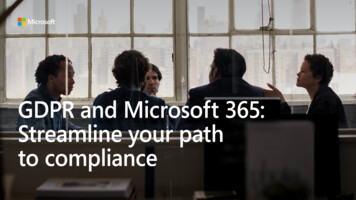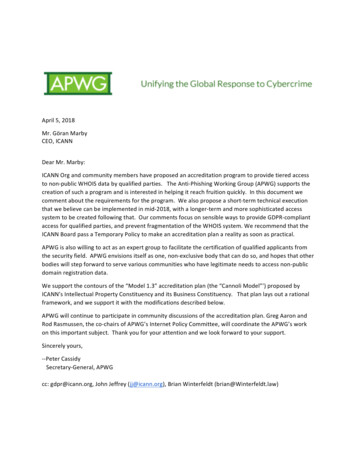
Transcription
April 5, 2018Mr. Göran MarbyCEO, ICANNDear Mr. Marby:ICANN Org and community members have proposed an accreditation program to provide tiered accessto non-public WHOIS data by qualified parties. The Anti-Phishing Working Group (APWG) supports thecreation of such a program and is interested in helping it reach fruition quickly. In this document wecomment about the requirements for the program. We also propose a short-term technical executionthat we believe can be implemented in mid-2018, with a longer-term and more sophisticated accesssystem to be created following that. Our comments focus on sensible ways to provide GDPR-compliantaccess for qualified parties, and prevent fragmentation of the WHOIS system. We recommend that theICANN Board pass a Temporary Policy to make an accreditation plan a reality as soon as practical.APWG is also willing to act as an expert group to facilitate the certification of qualified applicants fromthe security field. APWG envisions itself as one, non-exclusive body that can do so, and hopes that otherbodies will step forward to serve various communities who have legitimate needs to access non-publicdomain registration data.We support the contours of the “Model 1.3” accreditation plan (the “Cannoli Model”’) proposed byICANN’s Intellectual Property Constituency and its Business Constituency. That plan lays out a rationalframework, and we support it with the modifications described below.APWG will continue to participate in community discussions of the accreditation plan. Greg Aaron andRod Rasmussen, the co-chairs of APWG’s Internet Policy Committee, will coordinate the APWG’s workon this important subject. Thank you for your attention and we look forward to your support.Sincerely yours,--Peter CassidySecretary-General, APWGcc: gdpr@icann.org, John Jeffrey (jj@icann.org), Brian Winterfeldt (brian@Winterfeldt.law)
WHOIS Tiered Access and Accreditation Program:Proposal and Comments from the Anti-Phishing Working Group (APWG)version 1.0, 5 April 2018Authors:Greg Aaron (iThreat Cyber Group; APWG Senior Research Fellow)Pat Cain (Resident Research Fellow; APWG Board of Directors)Peter Cassidy (APWG Secretary-General; APWG Board of Directors)Dave Jevans (Chairman, APWG Board of Directors)Rod Rasmussen (R2Cyber; Co-Chair APWG Internet Policy Committee)CONTENTSEXECUTIVE SUMMARY4ABOUT THE APWG5LEGITIMATE ACCESS FOR SECURITY AND STABILITY NEEDS7ACCREDITATION PLAN OVERVIEW9COMMENTS ON THE “1.3 MODEL” (“CANNOLI”) BY THE IPC and BC10Section 1: Cybersecurity & OpSec Investigators10Section 2: Intellectual Property10Validation and Review of Access Purposes10Legitimate and Lawful Purposes10Process for Vetting and Accreditation10Proposed Operating Model102
Logging12Central Access Authority12Penalties13Data Access13OTHER NOTES REGARDING TECHNICAL IMPLEMENTATION14APWG PARTICIPATION IN CERTIFICATION PLAN15Appendix A: Justifications for Processing under Recitals in GDPR163
EXECUTIVE SUMMARYICANN Org has proposed an accreditation program to provide tiered access to non-public WHOIS data.1This program would involve “codes of conduct which would establish the standardized criteria,limitations, and responsibilities for granting access to non-public WHOIS data to the accredited parties.Selection of the accredited parties could be facilitated by designated expert groups.”In this document we comment about the overall requirements for any ICANN accreditation program.APWG is also willing to act as an expert group to facilitate the certification of qualified applicants fromthe security field.We recommend that the ICANN Board pass a Temporary Policy to make an accreditation plan areality, directing the participation of the registry operators and registrars. Below ( we propose atechnical execution scheme that we believe will be practical to implement in mid-2018, thereby enablingaccess for authorized parties while a longer-term program is developed. (See “Proposed OperatingModel” on pages 10-12.)We support the contours of the “Model 1.3” accreditation plan (the “Cannoli Model”) proposed byICANN’s Intellectual Property Constituency and Business Constituency.2 That plan lays out a rationalframework, and we support it with the modifications described below.The below document has been reviewed by the APWG Board of Directors.1As of this writing, ICANN Org’s “Proposed Interim Model for GDPR Compliance“ or “Calzone” interim model, ation-process-1-3-27mar18en.pdf4
ABOUT THE APWGThe Anti-Phishing Working Group (apwg.org) is a not-for-profit research, educational, and industryassociation, which conducts its activities through a U.S.-incorporated non-profit 501(c)6. APWG'smission is to aid response to cybercrime and cultivate globalized, mutualist responses to it through dataexchange, research, and public awareness. The APWG operates cybercrime data exchanges, publishescybercrime statistics, and presents international cybercrime conferences. It has more than 2,200members worldwide, including Internet infrastructure and service providers, financial servicescompanies, telecom providers, government CERTs, antivirus firms, and researchers.APWG.EU (www.apwg.eu) is a chapter of the APWG, and was founded in 2013 as a Spanish non-profitscientific research foundation. APWG.EU’s mission is to engage European businesses and organisationsin the fight against identity theft and Internet-based crime. As part of this mission, APWG.EU organisesand presents at least one cyber-crime convention per year. The foundation is strictly not-for-profit, andis supported by donations, nominal membership fees, and grants.Among the APWG’s activities are: Data exchange:o Since 2003 APWG has operated its URL Block List (UBL) and successive generations of itsprogeny, the eCrime Exchange [v.5.2.0], which aggregates machine event reportsrelated to common cybercrime such as phishing from global contributors and distributesthose data to browser developers, antivirus vendors, cybercrime responders, forensicanalysts and researchers worldwide, delivering hundreds of millions of records permonth to its members.o The APWG eCrime Exchange (eCX) incorporates the APWG Malicious DomainSuspension (AMDoS) program, now in revision.o The APWG’s 2018 Symposium on Policy Impediments to eCrime Data Exchange willaddress cybersecurity regulations, laws, treaty conventions, and interpretations thataffect the sharing cybercrime event data. This year’s program will focus extensively onthe provisions of the EU's new General Data Protection Regulation (GDPR).o Charter member of the Zero Botnet Alliance, a collaborative effort to track anddisseminate threat data related to criminal botnets.o The APWG Crypto Currency Working Group helps cryptocurrency exchanges, wallets,investment funds, and consumers protect against phishing and targeted attacks.o APWG has authored technical standards for data exchange (RFC5901).Research and Education:o APWG publishes quarterly and semi-annual reports that provide authoritative metricsabout phishing and identity theft.o APWG is the organizer of the annual eCrime Researchers Summit, the only peerreviewed conference dedicated to cybercrime studies, the proceedings of which are5
published by the IEEE. APWG also organizes and hosts other events each year, includingits including its Symposium on Global Cybersecurity Awareness in Europe.o APWG is co-founder and principal architect/organizer of the STOP. THINK. CONNECT.Messaging Convention, the global online safety public-awareness collaborative nowdeployed by national campaign curators in 19 countries.Technical and Public Policy: APWG is an expert advisor and research correspondent togovernance bodies, standards organizations, national governments, and treaty organizations.Among them are the Internet Engineering Task Force (IETF), the Council of Europe's Conventionon Cybercrime, the United Nations Office on Drugs and Crime, the Organization for Security andCooperation in Europe and the Organization of American States. The APWG is also on thesteering group of the Commonwealth Cybercrime Initiative of the Commonwealth of Nations.6
LEGITIMATE ACCESS FOR SECURITY AND STABILITY NEEDSAn accreditation plan for qualified parties to access non-public WHOIS data is consistent with theGDPR’s explicit mechanisms to balance the various legitimate public and private interests at stake,including privacy, security, and accountability. Access is justified especially under GDPR recitals 47, 49and 50,3 which allow uses “in the public interest” including but not limited to “preventing fraud”;“ensuring network and information security,” including the ability to resist “unlawful or maliciousactions”; and reporting possible “criminal acts or threats to public security” to authorities. Forapplicable references from the GDPR, please see Appendix A. Articles 40 to 43 of the GDPR describe themechanisms and requirements for accreditation programs, including codes of conduct, monitoring ofcodes of conduct, and certification bodies.ICANN’s Governmental Advisory Committee (GAC) recognizes the above, and recently reiterated that“The current WHOIS system helps achieve many such public policy interests, including enhancing trust inthe DNS, ensuring consumer protection, protecting intellectual property, combating cyber-crime, piracyand fraud, to cite but a few of the elements highlighted already in the GAC’s 2007 WHOIS Principles."4The APWG’s members are engaged in protecting themselves and their customers from an array ofthreats including phishing, malware, DDoS attacks, and network intrusions. For more than a decade,the APWG has been participating in ICANN and describing how its members rely on WHOIS data forthese purposes.5Blocked access to contact data in WHOIS will significantly harm the public interest by hamperinglegitimate access to critical information which allow parties to enforce laws and contracts, protectconsumers, detect and mitigate abuse, and protect critical infrastructure. The Internet is a network ofnetworks that is mainly operated by private parties and self-regulated through contracts and privaterelationships. Any party can send traffic to another, and the operator of any resource on the Internethas a responsibility to act in an appropriate and accountable fashion. Among other problems, ICANN’sproposed access model severely impacts contactability (the ability to reliably identify and/or reach outto domain operators); the ability to identify malefactors; and the ability to correlate data to detect andmitigate abuse and crime.While law enforcement plays a vital role in investigating and prosecuting crime, law enforcementbecomes involved in only a tiny percentage of e-crime and abuse incidents on the Internet. Instead,private entities are the ones on the front lines of Internet security and stability, responsible every3See https://gdpr-info.eu/recitals/ and 19-2016INIT/en/pdf4ICANN61 GAC s/public/20180315 icann61%20gac%20communique final.pdf5See for example “Advisory on Utilization of Whois Data For Phishing Site Take Down”:http://docs.apwg.org/reports/apwg-ipc Advisory WhoisDataForPhishingSiteTakeDown200803.pdf and “Trends inAbuse and the Need for Mitigation”: ion 1&modificationDate 1489483612000&api v27
minute for protecting their networks, services, and users. Indeed, law enforcement relies every day oncooperation with and referrals from private entities who are members of APWG. As Europol’sEuropean Cybercrime Centre stated, “Removing the cybersecurity community’s access to Whois datawill thwart existing cybersecurity mitigation techniques and further empower the ability of cyberattackers to scale their infrastructure with more persistent campaigns. Given the centrality of DNS abuseto an enormous volume of malicious cyber activity, and the current role of cybersecurity companies andindependent researchers in defending would-be victims via Whois data, such access remains necessaryand is vital to a multi-stakeholder approach to cybersecurity."6Without access to domain name registration data by security operators, investigators, responders, andresearchers, the Internet will become a place with much less security, stability, accountability, andability to regulate emodels26jan18-en.pdfand ls25jan18-en.pdf8
ACCREDITATION PLAN OVERVIEWAt a high level, we assume that the basics are:1.2.3.4.ICANN approves an accrediting body or bodies.These bodies evaluate applicants and approve (certify) the qualified ones.Approved parties must agree to terms of service that codify compliance with GDPR.Approved parties receive access. Below we describe a short-term access plan that can beimplemented quickly by at least some registrars and registry operators. (See “ProposedOperating Model” on pages 10-12.) Longer-term the community will need to come up with amore sophisticated plan that involves industry-wide adoption of the Registration Data AccessProtocol (RDAP) protocol and a more sophisticated technical credential system.ICANN must devise appropriate contractual language that requires the contracted parties toparticipate in the accreditation program, with participation requirements that will be effective andcan be enforced by ICANN’s Compliance Department. In the short term this could be done via aTemporary Policy7. This would allow lawful access to the data and would allow up to one year forICANN Org to create modifications to the RAA and registry contracts, and to deploy the RDAP protocol,which would then allow for a more sophisticated, longer-term technical implementation.This plan will help fulfill the ICANN GAC’s Consensus Advice8 to: 78“Ensure continued access to the WHOIS, including non-public data, for users with a legitimatepurpose, until the time when the interim WHOIS model is fully operational, on a mandatorybasis for all contracted parties” and“Ensure that limitations in terms of query volume envisaged under an accreditation programbalance realistic investigatory cross-referencing needs” and“Consider the use of Temporary Policies and/or Special Amendments to ICANN’s standardRegistry and Registrar contracts to mandate implementation of an interim model and atemporary access mental Advisory Committee?preview /27132037/53674097/20180315 ICANN61%20GAC%20Communique Final.pdf9
COMMENTS ON THE “1.3 MODEL” (“CANNOLI”) BY THE IPC and BCBelow we comment on the “Model 1.3” or “Cannoli Model” proposed by ICANN’s Intellectual PropertyConstituency and Business Constituency.9 That plan (described on pages 4-14 of the 1.3 draft) lays outa rational framework. APWG supports “Model 1.3”with the modifications below and looks forward tohelping make refinements.Section 1: Cybersecurity & OpSec InvestigatorsThe list of examples of services covered should include “financial services”. The list of examples ofentities in this category should include HSBC, JPCERT/CC, and REN-ISAC.Section 2: Intellectual PropertyWe note that cybersecurity and operational security actors in Section 1 may occasionally use intellectualproperty issues as a legitimate reason for accessing non-public WHOIS data. As examples, phishing iscriminal theft that also involves consumer confusion and misappropriation of trademarks, and somesecurity actors address consumer fraud and product counterfeiting, which involve both fraud andintellectual property violations.Validation and Review of Access PurposesFurther below we comment regarding remedies for inappropriate use.Legitimate and Lawful PurposesWe note that cybersecurity and operational security actors use domain registration data for purposes inmultiple categories here, including Legal Actions, Security/DNS Abuse Mitigation, Forensic Analyses,Contractual Enforcement, and Public Health and Safety.Process for Vetting and AccreditationRegarding “Cybersecurity & OpSec Investigators: Verifiable credentials and letters of authority”: we notethat the term “credentials” will need appropriate definition, and examination by each accrediting body.In general the goal is for applicants to prove their identity, qualifications and achievements, and provideevidence that they are suitably skilled and competent to observe the data protection requirementsattendant accessing non-public WHOIS data. In the security sphere, some entities will be able topresent “official” certifications (for example banks possess government charters). Other securitypractitioners operate in spheres that are not similarly regulated or licensed.Proposed Operating ModelWe propose an alternate plan that we believe may be easier to implement for the shorter 1-3-27mar18en.pdf10
The “Cannoli Model” proposes “Upon accreditation, users are given credentials to access Whois data.Users are able to present their credentials to a Whois database operator who validates credentials witha federated, centralized access authority and then provides access to Whois data.” Such a credentialingsystem cannot be built quickly. Instead, our plan avoids those problems.Our proposal for the short term is:1. Approved parties designate their rationale for access under GDPR, i.e. their legitimate reasonsfor accessing the data and the use(s) they will put it to.2. Approved parties designate the IP addresses from which they wish to query WHOIS servers.3. The accrediting bodies provide those IP addresses to ICANN, which collects them into a singlelist.4. All WHOIS server operators (registries and registrars) will be required to pick up that list fromICANN on a daily basis. They must white-list WHOIS access from the approved IP addresses,and provide full WHOIS data (“thick” data, containing contact data) for queries coming fromthose IP addresses.Port 43 access managed by IP range is appropriately secure -- it ensures that only approved parties cangain access to the non-public data. The registries and registrars can log queries by IP and thus byaccredited user.GoDaddy already offers exactly this tiered access service on its port 43 servers. Anonymous users whoquery GoDaddy’s WHOIS server cannot view contact data. But GoDaddy recognizes the IP addresses ofauthorized users, and provides them with full WHOIS responses that contain contact data.10Some registrars already log what WHOIS queries are made for what specific domain names, by IPaddresses.11 All major industry players already use IP addresses to impose rate-limiting on their port 43servers, and use white-listing to give authorized users higher query limits. Offering tiered WHOIS accessto authorized IP addresses is a modification of this practice. We believe that many parties couldimplement our proposed solution, as GoDaddy has, at least as easily as any other solution. The majorindustry players all have the technical wherewithal to make the changes on an expedited schedule, andtogether they manage the majority of gTLD domain names.The “Cannoli Model” also requests a centralized access point. Specifically it proposes access leveragingthe existing ICANN web-based centralized Whois system12. Web-based access is designed for humanusers and single lookups, and is not suitable for automated access. APWG emphasizes that port 43access is vital because it allows users to make automated, machine-based queries. And in the shortterm, creating a central access point at ICANN (or anywhere else) would be a project involving 1)credential management (distributing usernames and passwords to users), and 2) a query logging systemoperated at ICANN, and 3) requires the server operators to provide tiered access to ICANN’s system ints2742111For example see is-searches-decide-domain-renewals/and cann.org/en/lookUP?name 11
provide tiered access by IP). These all can’t be implemented quickly. Our plan avoids tasks #1 and #2entirely. If web-based access is needed by some users, perhaps an approved entity can build access forother approved users, providing usernames/passwords and logging queries as needed.Over the longer term, we agree that a more sophisticated mechanism should be developed. Registriesand registrars will need to adopt RDAP, which offers additional authentication features and moregranular control of output. RDAP deployment will not happen for some time--at least six months fromwhen ICANN Org and the contracted parties agree on a deadline. Between now than then, parties couldwork out the implementation and rollout details.We must avoid a situation in which every accredited party must go to every single registrar and registryoperator and seek access or credentials from them individually. That situation is a nightmare for allinvolved and is highly impractical. ICANN faced a similar situation when the new gTLDs launched andparties would start seeking zone file access for the thousand-plus new gTLDs. The ICANN communitysolved that problem by establishing the Centralized Zone File Access System (CZDS), which offers acentralized place for parties to manage their subscriptions.Logging Registries and registrars will be able to log what parties are querying which domain names.ICANN must ensure that this log data remains confidential under all cases. Revealing that datato registrars or other parties could compromise investigations, especially by law enforcement.Regarding “Logs will include accredited entity, purpose, query, and data”: granularsophistication will be possible under a longer-term, RDAP-based system.Central Access AuthorityThe “Cannoli Model” states that “Application and renewal fees should be sufficient to cover onboardingand support fees for the authorization and access system.” We disagree, for the following reasons:1. This would be tantamount to charging for WHOIS access. It should never be charged for.ICANN’s historical approach -- reflected in its registry and registrar contracts and its new gTLDapplication program -- has always been that:a. WHOIS is a public resource.b. WHOIS is provided for a wide variety of legitimate uses and is necessary for the stability,security, and trustworthiness of the namespace and the Internet in general.c. WHOIS is a core service provided by registries and registrars. It is not a value-added orrevenue-generating service.2. Charging for WHOIS would shift costs from malefactors to the defenders who keep the Internetsafe.3. The suggestion is unfair to the certifying organizations and the certified users users, who willlikely have no control over the costs incurred by the party running the authorization and accesssystems.Instead, the authorization and access system is an appropriate use of ICANN funds. This is an essentialinfrastructure support service of the type that ICANN exists to maintain, and it is no different fromhaving ICANN fund and operate the CZDS. Also, GDPR imposes certain new costs on registrars and12
registry operators. This is a simple consequence of the legislation, and is part of doing business in theEuropean Union and servicing customers in EU member states. Passing those costs on the Internetdefenders is not appropriate. The appropriate solution is to subsidize the costs via registry and registrarfees.The “Cannoli Model” states that “Login and authorization for access by accredited entities to Whoisdatabase operators at registries and registrars will be provided by a third-party or parties.” Or, it mightbe provided by ICANN. The mechanics of a federated, centralized access authority need to be workedout.PenaltiesWe believe that de-accreditation and referral to EU privacy authorities are the effective and practicalremedies. These are the steps required by the GDPR’s Article 41.13The “Cannoli Model” suggests “financial penalties” imposed by the accrediting bodies. This should bestricken. Under the law, the EU authorities have the primary responsibility for seeking financialpenalties for non-compliance with GDPR. It may not be possible for accrediting bodies to imposefinancial penalties under contract law, which in many countries permit actual damages for breach ofcontract (established by a court or arbitration) but not punishment (punitive damages). (This is a reasonwhy ICANN’s registry and registrar contracts do not contain escalating financial penalties for noncompliance.) Finally, private parties have direct legal recourse against accredited users who violatetheir rights.Data AccessWe agree that accredited access should not be rate-limited except to prevent system overload. In itslatest Consensus Advice, the GAC advised the ICANN Board to instruct the ICANN Organization to"Ensure that limitations in terms of query volume envisaged under an accreditation program balancerealistic investigatory cross-referencing needs".14 This means that registrars and registry operators mustnot impose rate-limiting on accredited users that would prohibit them from making enough WHOISqueries to do their work. Some security operators need to perform significant numbers of queries sothat they can find and monitor abuse across large numbers of domains and find bad actors registeringacross TLDs and registrars. This piece of advice needs to be incorporated into any Temporary Policy inthe short term, and into contracts s/public/20180315 icann61%20gac%20communique final.pdf13
OTHER NOTES REGARDING TECHNICAL IMPLEMENTATIONIn a recent letter to ICANN15, the Contracted Parties raised several complications to the introduction ofany access system. Our evaluation of those objections are as follows: “Creating a centralized credentialing system will take significant time, as it will require inputfrom across the ICANN community.” Our short-term plan does not require a true centralizedcredentialing program.“The timeline for that effort will be measured in quarters (or possibly years), rather thanmonths, due to the complexities inherent in disclosing data across jurisdictions and otherfactors.” ICANN’s Interim Model states that all registrars will continue to transfer contact datato registries and escrow providers, assumes that registration data will cross borders, and statesthat an accreditation process is a legally viable option. As such it does not recognize crossborder transfer as a concern that should delay access.The Contracted Parties plan “assumes that individual contracted parties will need to handlecredentialing in the meantime in order to continue providing access to non-public WHOIS data”,and that each registry and registrar “independently develops internal policies for what partiescan get access, what data elements those parties can access once credentialed (recognizing thatunlimited access to all WHOIS records for every credentialed parties is not likely to be compliantunder GDPR), procedures for processing requests, etc.” We question these assumptions.Allowing each operator to come up with its own policies and procedures will be a disaster. Itwill result in loss of access to many registries and registrars even for law enforcement, will makeit very difficult for other users who have legitimate right to access the data, and will not be anenforceable situation for the ICANN Compliance Department . It is the kind of non-scalablesituation that ICANN decided was unacceptable for zone file access (see above). Instead, it isthe responsibility of ICANN to put a predictable and enforceable model in place.The Contracted Parties only offer one solution for automated access — RDAP. Our short-termplan continues the use of port 43 WHOIS until RDAP is -icann-proposedcompliance-models-26mar18-en.pdf14
APWG PARTICIPATION IN CERTIFICATION PLANPer Articles 40 to 43 of GDPR, ICANN evidently must present an accreditation plan to an EU SupervisoryAuthority. The "Article 29 Working Party Draft Guidelines on the accreditation of certification bodiesunder Regulation (EU) 2016/679"16 is the relevant guide to accreditation. Those Guidelines state theremust be an established certification body (or bodies), a “third-party conformity assessment bodyoperating a certification mechanism.” That certification body will undertake certifications of partiesseeking access to non-public WHOIS data. Certifications are ”the assessment and impartial, third partyattestation that the fulfilment of certification criteria has been demonstrated" and that a party isconformant and can access the data. A scheme owner is “an identifiable organisation which has set upcertification criteria and the requirements against which conformity is to be assessed. The accreditationis of the organisation that carries out assessments (Article 43.4) against the certification schemerequirements and issues the certificates (i.e. the certification body, also known as conformityassessment body). The organisation carrying out the assessments could be the same organisation thathas developed and owns the scheme, but there
mechanisms and requirements for accreditation programs, including codes of conduct, monitoring of codes of conduct, and certification bodies. ICANN's Governmental Advisory Committee (GAC) recognizes the above, and recently reiterated that "The current WHOIS system helps achieve many such public policy interests, including enhancing trust in
